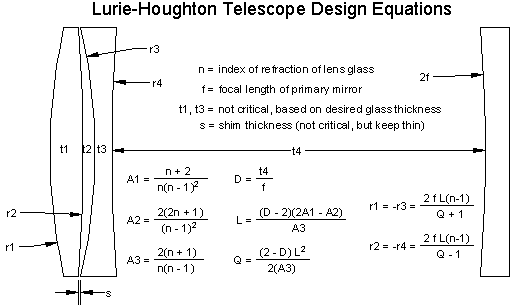Lurie–Houghton telescope

The Lurie–Houghton telescope is a catadioptric telescope. Lurie modified the original design[1] by Houghton by adding a diagonal mirror to direct the focused light outside the telescope tube as in a Newtonian telescope. The Houghton design was patented[2] on May 30, 1944. Instead of the fairly hard to make Schimdt and Maksutov corrector lenses, the corrector for the Lurie–Houghton is relatively easy to make. It consists of two lenses, a positive and a negative, at the front of the telescope which sets the size of the aperture. All lens and primary mirror surfaces are spheroidal which eases construction. These lenses are relatively thin, though not as thin as the Schmidt corrector. With a good antireflection coating, light loss and reflections are minimal.
The corrector
Each surface of the lenses in the corrector creates a degree of freedom to correct optical aberrations. There are enough degrees of freedom to correct for spherical aberration, coma, and field curvature. The total power of the Houghton corrector lens is by definition zero. It is used in the path of the incoming light rays, which are parallel, so the residual chromatic aberration is essentially zero. The Houghton corrector can be made of the same type of glass (usually BK7) which reduces cost. The design tolerances are very modest compared to e.g., Maksutov telescopes.
There are two types of correctors, symmetric and asymmetric. In the symmetric version R1=-R3, R2=-R4 which allows for interferometry testing of the surfaces against each other. However, the correction is slightly worse than the asymmetric corrector with four different radii. The following figure presents the equations necessary to design the corrector. Note that in these equations D is not the diameter of the primary mirror. Instead, it is the distance from the mirror to the corrector as a fraction of the focal length of the mirror.

The mirrors
The Lurie–Houghton uses a spheroidal primary mirror unlike the paraboidal mirror used in the Newtonian telescope. A spheroidal mirror is much easier to make because the entire surface appears to evenly black out when tested with a Foucault tester. In the Houghton and the Lurie–Houghton, the radius of curvature of the primary mirror is slightly less than that of the total system. The diameter of the primary mirror should be larger than the aperture set by the corrector to avoid vignetting.
The secondary mirror in the Lurie–Houghton is comparable to the secondary mirror in a Newtonian telescope. An advantage of the Lurie–Houghton over the Newtonian is that the secondary mirror can be mounted to one of the corrector lenses thus eliminating the spider mount. This eliminates diffraction of the incoming light that is caused by the vanes of the spider mount.